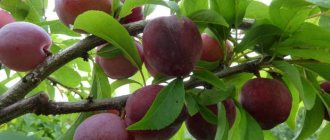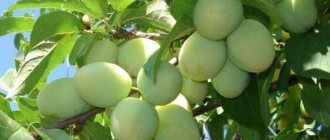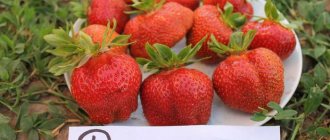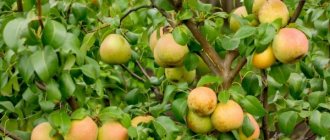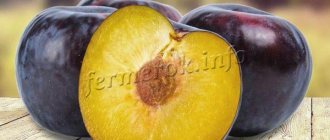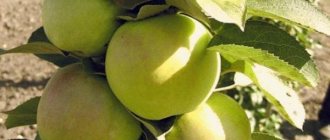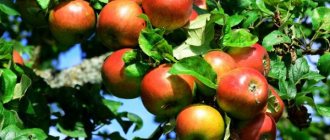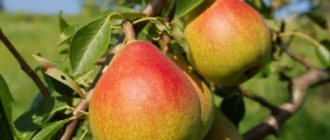Description of the plum variety Opal
Plum Opal is a low tree, reaching 2.5–3 m. The crown is compact, dense, and round in shape. The leaves are elongated, dark green.
Description of the fruits of the Opal variety:
- medium sizes;
- average weight – 30 g;
- round or oval shape;
- thin skin, when ripe, changes color from greenish-yellow to purple;
- covered with a bluish wax coating;
- the pulp is juicy, dense, yellow;
- a small elongated bone, pointed at the ends.
The fruits have a good sweet and sour taste and aroma. Tasting qualities are rated 4.5 points. The sugar content in the pulp is 11.5%. The pit is located freely and leaves about 5% of the plum mass.
The Opal plum is recommended for cultivation in the central and southern regions of the Non-Black Earth Region. The variety grows on its own roots. In regions with an unfavorable climate, it is grafted onto winter-hardy plum trees.
Advantages and disadvantages
As is clear from the description, the “Opal” variety has a large number of advantages that allow you to choose it for your garden plot. The main advantages of this type:
- healthy and tasty fruits;
- good resistance to diseases and insects;
- a bountiful harvest;
- early ripening;
- ease of care;
- ease of separating the seeds from the pulp.
Of course, like any crop, the Opal plum also has several disadvantages. Among the pitfalls of growing the variety:
- irregular harvest (plum bears fruit once every two years);
- if the harvest is too large, the fruits are smaller and less tasty;
- the tree does not like severe frosts;
- the fruits have a high sugar content (diabetics and overweight people are advised to use them very carefully).
Read more:
- Red plum: description of varieties, taste and nutritional value
- Plum Testament variety description
- Plum Giant description of the variety
- Cherry plum description - Summer resident's guide
Characteristics of the variety
Before purchasing a plum, its main characteristics are taken into account: resistance to drought and frost, the need for planting pollinators, yield and timing of fruit ripening.
Drought resistance, frost resistance
Drought resistance is rated as average. During drought, plum trees require constant watering. In the absence of moisture, the ovaries fall off and the yield decreases.
Frost resistance of the Opal variety is below average. When the temperature drops to -30 °C, the tree freezes slightly, but quickly grows its crown. Productivity is restored after 1–2 years.
Opal plum pollinators
The Opal variety is self-fertile. Planting of pollinators is not required for the formation of ovaries.
Opal plum can be used as a pollinator for other varieties:
- Smolinka;
- Morning;
- Blue gift;
- Extra early;
- Hungarian Moscow.
Attention! The presence of different varieties of plums on the site, blooming at the same time, has a positive effect on their productivity.
The Opal plum blooms from mid to late May. The harvest ripens in early August. Fruiting is not extended over time: the fruits are harvested within a week.
Productivity and fruiting
When growing the Opal plum on cherry plum seedlings, fruiting begins in the 3rd year after planting, on zoned varieties - already in the 2nd year. An adult tree over 8 years old produces 20–25 kg of fruit.
The harvest volumes of the Opal plum are unstable. After abundant fruiting, there is a possibility that the next year will be less productive.
With a large number of fruits on the branches, they become smaller and lose their taste. Harvest rationing will help correct the situation. During the flowering period, remove excess buds.
Area of application of berries
Opal plum is used both fresh and processed. Desserts and fillings for baked goods are prepared from it. Homemade preparations are made from plums: confitures, jams, preserves, compotes.
Resistance to diseases and pests
Resistance to diseases and pests is average. In cold and rainy weather, the Opal variety is susceptible to cleasterosporia and other fungal diseases.
Advantages and disadvantages of the variety
Advantages of the Opal plum variety:
- early maturation;
- universal purpose of fruits;
- high productivity;
- unstable fruiting;
- self-fertility;
- resistance to diseases.
Disadvantages of plum Opal:
- with high yields, the fruits become smaller and lose their taste;
- low winter hardiness;
- in cold regions, grafting onto more winter-hardy varieties is required.
You can be convinced of the merits of the Opal plum by comparing it with other representatives of the species:
Reviews from gardeners
Apparently, due to the low popularity of the variety, almost no reviews about it were found on the forums.
Opal needs to be grafted into the crown of a winter-hardy plum, the same Tula black one.
Amateur, Moscow region
https://forum.tvoysad.ru/viewtopic.php?t=562&start=30
Opal's fruits are very tasty with a special, unique aroma. But it was Opal that suffered more than other varieties both in VSTISP and even in the Krasnodar Territory last year (2006). G. Eremin spoke about this at his last lecture at MOIP.
Tamara, Moscow
https://forum.tvoysad.ru/viewtopic.php?t=562&start=30
Spoiled residents of the southern regions will most likely choose more modern and “advanced” varieties. But in the middle zone and Moscow region, the Opal plum is quite suitable for growing, given that it has much fewer disadvantages than advantages. It can be an excellent addition to other, later varieties, while being a good pollinator for them.
Landing Features
The Opal plum tree is planted in autumn or spring, depending on the weather. Its yield depends on the correct choice of place for growing a crop.
Recommended timing
In the middle zone, plums are planted in the fall, after leaf fall. The plant manages to take root before the onset of frost.
In cold climates, it is better to postpone planting until spring. Work is carried out in the spring, before the buds open.
Choosing a suitable location
Plum loves well-lit places, protected from the wind. To ensure that the roots of the tree do not suffer from moisture, groundwater should be no higher than 1.5 m.
Advice! If you place the plum on the south or west side of the site, the tree will receive the necessary natural light.
Plum is undemanding to soil composition. The exception is acidic soil, which is detrimental to wood. The maximum yield is obtained when the crop is grown in fertile, well-drained soil.
What crops can and cannot be planted nearby?
- Plum does not tolerate the proximity of birch, poplar and hazel.
- The tree is removed from other fruit crops at a distance of 4 m or more.
- Raspberries, currants or gooseberries are planted between the rows of plums.
- Shade-loving herbs and primroses grow well under the tree.
Selection and preparation of planting material
One- or two-year-old seedlings of the Opal variety are chosen for planting. They are purchased from nurseries or other gardening centers. Seedlings are assessed visually and specimens free of mold, damage and other defects are selected.
Before planting, the roots of the Opal plum are placed in clean water for 3 hours. If you add a few drops of the Kornerost stimulant, the tree will take root faster after planting.
Landing algorithm
Planting procedure for Opal plum:
- First, prepare a pit measuring 60*60 cm and 70 cm deep.
- Fertile soil, peat and compost are mixed in equal quantities.
- In heavy clay soil, a drainage layer should be provided. A layer of crushed stone or expanded clay 10 cm thick is poured onto the bottom of the pit.
- Half of the excavated soil is placed in the hole and left to shrink.
- After 2–3 weeks, the remaining soil is poured into the hole, and a seedling is placed on top.
- The roots of the plum are covered with earth.
- The tree is watered abundantly. The tree trunk circle is mulched with peat.
Growing technique
It must be remembered that plum trees cannot be replanted, so you should immediately choose the right place for the tree. It is advisable to choose a large and well-lit area, but with protection from blowing. The seedling is placed at a distance of at least three meters from nearby buildings and trees.
Many gardeners recommend planting plum trees so that they are covered on the north side, where cool winds most often blow.
For planting, level soil is usually used. Otherwise, excess air will form and stagnate in microcavities. It is imperative to lime the soil, since plums will not be able to grow in acidic and peaty soil. For normal tree development, loamy soil in combination with humus and a small amount of sand is suitable. Groundwater should flow at a depth of 1.5-2 meters.
Read also: Tomato Kuum: characteristics and description, reviews, photos, variety yield
It is best to purchase seedlings in the fall and plant them in the spring. In order for the trees to comfortably overwinter, they are buried in a place well protected from drafts. To do this, you need to dig a small oblong hole and place the seedlings there. The top of the future plums is sprinkled with damp soil and covered with a thick but breathable cloth or burlap.
Preparations for planting begin in mid-spring: old roots and remnants of weeds are removed, the ground is cleared, it is dug up and holes are made. Soil in combination with compost is placed on the bottom, a seedling is placed on top, the roots are evenly distributed and covered with soil. It is worth remembering that after planting the soil must be mulched.
Aftercare for plums
- The Opal plum is watered 3 to 5 times during the season. The tree needs moisture during flowering and fruiting. Up to 10 buckets of water are poured under the drain.
- The watered soil is loosened so that moisture is better absorbed.
- Feeding the Opal plum begins in early spring. 30 g of urea, superphosphate and potassium salt are dissolved in water. After flowering, fertilizing is repeated, but only phosphorus and potassium fertilizers are used.
- After 3–4 years, the soil under the trees is dug up.
For 1 sq. m add 10 kg of humus or compost. Important! Proper pruning helps shape the crown of the Opal plum and increase yield. - The plum crown is formed in tiers. Be sure to remove dry, frozen shoots. Plum trees are pruned in early spring or autumn.
- In late autumn, young plantings are hilled up and covered with agrofibre, burlap or spruce branches. Additionally, a snowdrift is thrown over them.
- To prevent rodents from damaging the tree trunk, it is covered with mesh or roofing felt.
Diseases and pests, methods of control and prevention
The main diseases of plum are listed in the table:
| Disease | Symptoms | Treatment | Prevention |
| Clusterosporiasis | Brown spots on leaves, cankers on fruits. | Spraying the tree with a solution of copper oxychloride (30 g per 10 liters of water). | 1. Trimming excess shoots. 2. Digging up soil in the tree trunk circle. 3. Preventive treatment with fungicides. |
| Fruit rot | Spots with fungal spores appear on the fruits. | Processing plums with Bordeaux mixture. |
Crop pests are listed in the table:
| Pest | Signs | Struggle | Prevention |
| Garden aphids | The pest forms colonies on plum shoots, as a result the leaves curl and dry out. | Spraying plums with a solution of the drug "Karbofos". | 1. Digging up the soil under the plum tree. 2. Cleaning up fallen leaves. 3. Treatment of plums in early spring with Nitrofen. |
| Silkworm | The caterpillar feeds on buds and leaves and leaves nests made of cobwebs in the branches. | Treatment with the drug "Entobacterin", infusion of tobacco or wormwood. |
